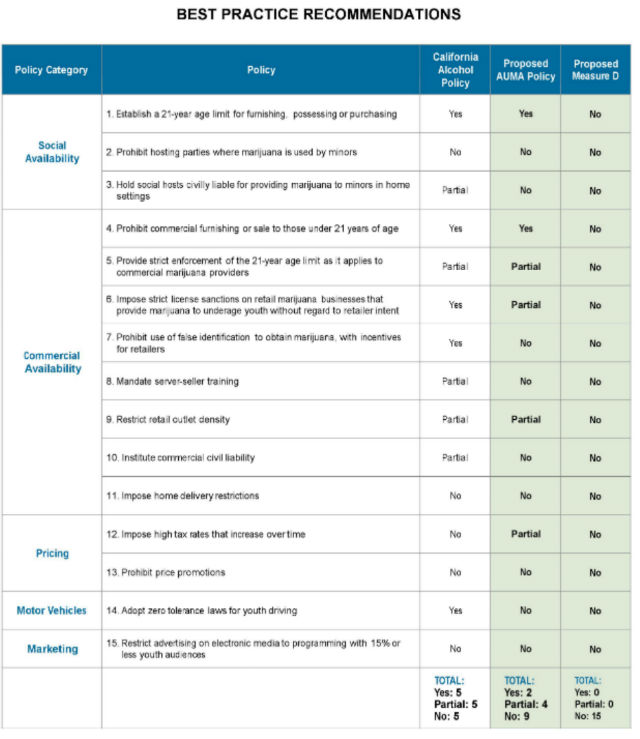Calaveras County, CA…The school superintendents in Calaveras County have come together to share with the public our concerns for the youth of Calaveras County related to marijuana cultivation and
accessibility. We believe it’s important for voters to have as much information as possible in order to make the best decisions for our students and for our community.

The chart above compares current California alcohol policy, the Adult Use of Marijuana Act, and
Calaveras County’s Measure D to best practice recommendations for policies to protect youth
from access to alcohol and marijuana and from the adverse effects of adolescent use of these
substances.
County schools will host two educational sessions on the effects of marijuana on the adolescent
brain, presented by Health Officer Dr. Dean Kelaita, 6-7pm, Thursday, October 13, 2016 at Bret
Harte High School Theater and 6-7pm, Wednesday, October 19, 2016 at Calaveras High
School Theater. Please join us.
Marijuana use has been shown to have measurable negative effects on the developing brain. A
growing number of scientists have concluded that delaying onset of marijuana use by
adolescents is critical to protecting our young people’s health.
A white paper produced by Ventura County Behavioral Health includes a great deal of research
in this area. The article is titled “What the Science Says About Adolescent Use of Cannabis” by
Linda Gertson, Ph.D. The full article, and all citations, can be accessed via the Calaveras
County Office of Education website, ccoe.k12.ca.us. Following are some of the highlights.
A national survey done in 2015 found that 6.5% of eighth graders, 14.8% of tenth graders, and
21.3% of twelfth graders use marijuana. The Fall 2015 California Healthy Kids Survey indicated
that in Calaveras County, 8% of ninth graders and 22% of eleventh graders had used marijuana
in the past 30 days. Fifty-five percent of our ninth graders and 75% of eleventh graders
considered marijuana “fairly easy” or “very easy” to obtain.
Research has shown that how young a person is when they start using marijuana is a strong
predictor of whether they will have a future substance use disorder. Kids who use marijuana
during adolescence are two to four times more likely to have symptoms of dependence in the
first two years.
Many scientific studies have shown a relationship between early use of marijuana and negative
effects on mental ability and educational achievement. A relationship has also been established
for several psychiatric conditions, particularly schizophrenia. The brain does not reach full
maturity until a young person is in their early twenties, and many complex brain functions are
still developing during adolescence.
Data from three studies involving more than 6,000 participants (Horwood et al., 2010) found that
rates of educational attainment were highest for those who had not used marijuana before age
18 and lowest for those who started using before age 15. The authors suggested that early use
of marijuana may negatively impact a young person’s ability to obtain a high school diploma or
move into higher education.
In a study assessing the effects of marijuana use on verbal learning and memory, even
adolescents with relatively brief exposure to marijuana demonstrated similar memory loss to
that reported in adult long-term heavy users. There was strong evidence of greater memory loss
the earlier marijuana use started.
The authors of several of the studies reviewed in the white paper emphasize the need for
prevention or delay of marijuana use in adolescence, and recommend efforts to ensure that
marijuana legislation consider the potentially adverse developmental effects of this drug.
Current research has shown that it’s critically important to keep marijuana away from children.
However, youth perception of harm from marijuana use has decreased in recent years. In
Calaveras County in 2007, 62% of ninth graders and 43% of eleventh graders thought that
smoking marijuana once or twice a week carried a risk of great harm. In 2015, only 44% of ninth
graders and 26% of eleventh graders felt that way.
Supporters of Proposition 64, California’s Adult Use of Marijuana Act (AUMA,) argue that the
initiative protects public health and safety generally, and potential risks to children and youth in
particular.
A policy report called “The 2016 California Marijuana Initiative and Youth: Lessons from Alcohol
Policy” prepared by James F. Mosher, JD, also for Ventura County Behavioral Health, analyzed
the AUMA proposal and compared it to federal best practices developed as a regulatory
structure for preventing youth access to alcohol. (Please see chart.) The full article, citations,
and an analysis of Measure D in this same context are also available via the CCOE website.
When voting on this or any other issue, we urge Calaveras voters to fully consider its impact on
our children.
Kathy Northington, County Superintendent of Schools
Mark Campbell, Superintendent, Calaveras Unified School District
Michael Chimente, Superintendent, Bret Harte Union High School District
Don Ogden, Superintendent, Vallecito Union School District
Julia Tidball, Superintendent, Mark Twain Union Elementary School District


